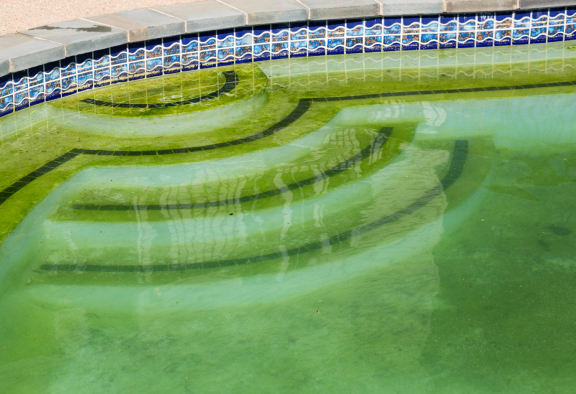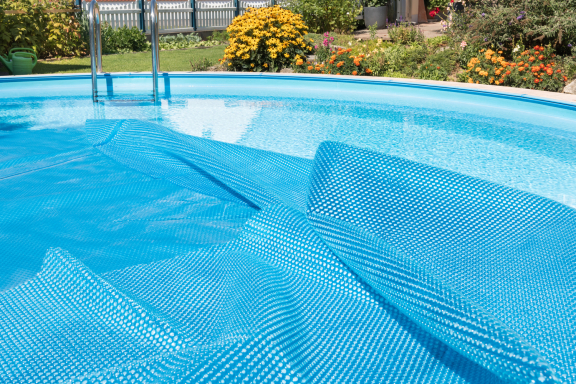Bromine pools: everything you need to know about their advantages and disadvantages!
Bromine is a less common pool water disinfection method than chlorine. However, it is a very attractive method that offers many advantages. So, how do you use bromine as a disinfectant? What are the advantages and disadvantages of this type of pool treatment? What specific installations are required? Find out everything you need to know before switching to bromine to treat your pool.
The operation of a bromine pool
Let's start with the basics: what is bromine and how does it work in a pool?
What is pool bromine?
Bromine is a member of the halogen family, like chlorine and iodine. It is found in nature, notably in seawater, but never in its pure form. In a pool, it disinfects the water to keep it clean and clear.
You can purchase bromine in shops in the form of tablets or granules.
What is the difference between bromine and chlorine?
Bromine and chlorine work in a similar way, both have the same type of disinfection properties. However, bromine is more reactive than chlorine and does not have the same inconveniences because it is odourless and non-irritating.
Bromine treatment is also easier and can provide continuous pool disinfection if you install a distributor.
What are the effects of bromine?
Bromine has a disinfecting effect when diluted in water. It eliminates bacteria, and acts against algae and fungi.
It also has a persistent capacity: it immediately purifies the water, but continues to destroy bacteria as they appear.
Is bromine dangerous?
Like chlorine, bromine is a harmful product that must be handled and stored with care. It can cause allergies, but this is less frequent than with chlorine. Bromine allergies generally appear after an overdose, so proper use of the product and regular maintenance are important.
The advantages and disadvantages of bromine treatment
Before undertaking bromine treatment, understanding the advantages and disadvantages of this product will ensure that you make the right choice and avoid unpleasant surprises.
The advantages of bromine
Why choose bromine rather than chlorine? Here are the advantages of this type of water treatment:
– Temperature: bromine is effective in water up to 30 °C, which is much higher than chlorine. This particularity makes it an ideal treatment for hot tubs, indoor pools and heated pools.
– pH variations: bromine is less sensitive to water pH. It remains effective for water disinfection even if the pH is high, which is not the case for chlorine, and it even requires a higher pH to be very effective.
– Bathing comfort: bromine is odourless and does not irritate the skin, mucous or eyes. It is therefore more pleasant to swim in a bromine treated pool than in chlorinated water, especially if you are sensitive to the odour of chlorine or in case of allergies.
– Its stability against UV rays: bromine is not highly sensitive to UV rays, which means that it does not deteriorate with sunlight. This means that it is not necessary to add a stabilising treatment to your pool, and you thus avoid over-stabilising, which is a problem that can be difficult to remedy.
– Use: bromine is easy to use and does not require stringent maintenance. However, be careful, it is a corrosive product when undiluted and must be handled with care.
The disadvantages of bromine
Bromine also has several disadvantages that other forms of treatment do not necessarily have:
– The cost: bromine is an expensive product. You should allow a budget 30 to 40% higher than for chlorine treatment.
– Harmfulness: like chlorine, and contrary to salt, bromine is a harmful chemical product. You must be very careful when handling this product, but also with its storage, especially if you have children or pets.
– The installation cost: you must install a brominator (also called a bromine feeder) for effective bromine pool treatment, which once again increases the budget. Allow between €80 and €250 for this device.
How to properly treat a pool with bromine
How exactly do you use bromine to treat your pool water?
Where do you put bromine in the pool?
Pool bromine can be purchased in two forms: granules or tablets. Its use depends on the form you choose.
Granules are placed directly in the pool skimmers. You must then allow them to act. Tablets, on the other hand, are placed in a brominator that is connected to the filtration system. In this way, the product is distributed continuously and progressively. The latter solution is the most recommended as it avoids the problem of the bromine dissolving too quickly.
How do you treat a pool with bromine?
To treat your pool with bromine, place the bromine tablets in the brominator. Part of the pool water is sucked in by the filtration system, which sends this water to the distributor for disinfection, before sending it back into the pool.
Maintenance of a bromine pool is less demanding because it is not necessary to add bromine to the distributor very frequently. Of course, this method is a complement to careful pool cleaning with a net and a pool vacuum cleaner.
The treatment can be completed with an algaecide to ensure that algae do not develop in the pool. You can also add a clarifier and a flocculant to keep the water very pure. Finally, a bromine regenerator will reinforce the effectiveness of the treatment.
What is the correct pH for a bromine pool?
The fact that bromine is effective with a high pH does not mean that it is not necessary to regularly monitor the pH level, in the same way as for a chlorine pool. However, the pH in a bromine pool must be kept above 7.5 for the treatment to be as effective as possible, and below 8 to avoid damaging the equipment.
Test the pH every week so that it remains well balanced. If the pH rises or falls too much, you can adjust it by pouring a pH– or pH+ product into the pool.

How do you avoidrust stains in your pool?
Proper pool maintenance is always important to keep the pool water clean and clear. It also prevents the development of rust stains.
Faulty filtration
If the problem is not solved, it is possibly due to the filtration system. Carefully check that no parts are damaged or broken. If everything appears to be in order, wait a few hours after brushing the pool sides to allow all the deposits to settle at the bottom of the pool before filtering.
How do you measure and adjust the bromine level?
The pool bromine level should be between 1 and 2 mg/litre (or between 2 and 4 mg/litre for a hot tub). As a general rule, it is necessary to add more in the brominator every two weeks.
To ensure you maintain a satisfactory level of bromine, check it regularly with a colorimetric test or an electronic pH-meter. The latter is more precise but also more expensive.
In order to calculate the required dosage, start by testing the pH before measuring the bromine level:
– For a pH over 7.5, the bromine level should be between 1.2 and 3 mg/litre;
– For a pH over 8.2, the bromine level should be between 3 and 5 mg/litre.
If the level is too low, you can add bromine tablets to the brominator, after ensuring that you have switched off the filtration system and have closed the valves.
A bromine regenerator can also help you, especially when the bromine level is below 1 or if your pool water starts to become cloudy. The bromine regenerator consists of active oxygen and will extend the effectiveness of the bromine by regenerating the bromamines that are already present in the water.
If your water contains too much bromine, you will have to empty part of your pool or use a bromine neutraliser.
Automating the bromine treatment
Installing a brominator is already a first step towards the automation of your pool treatment because it will constantly distribute bromine into your pool water.
To automate your bromine treatment even further, you can also install a pH regulator, which uses a sensor to measure the daily pH levels and rectify them whenever necessary. In fact, certain brominators have a built-in pH regulator.
How do you change from a chlorine to a bromine pool?
Convinced by bromine and want to stop using chlorine? Where do you begin?
Install a brominator
The equipment required for a bromine pool is quite similar to that of a chlorine pool, even if it is recommended to install a bromine feeder. A brominator will enable better distribution of the product and will facilitate maintenance.
Before installation, it is necessary to eliminate any trace of chlorine, because bromine is not compatible with active chlorine.
Ideally, the brominator should be installed in a by-pass on the hydraulic circuit. You will thus be able to manage the flow of water that passes through the brominator thanks to a valve and cut off access if necessary. Installation is quite difficult and it is best to call on a professional to ensure the job is done correctly.
Once the brominator has been installed, you can carry out a bromine shock treatment to quickly increase the bromine level in the pool.
Reconverting to chlorine
Perhaps you have tried bromine, but this method of pool water treatment does not suit you. Can you go back?
To go back to a chlorine pool, close the brominator valves to isolate it from the filtration system. Then use a bromine neutraliser to remove any trace from the water and then begin the new chlorine treatment.
Remedying green water in a bromine pool
Green water in your bromine pool means that algae have developed. First and foremost, you should carefully clean the pool, brushing the sides and bottom. You will also have to carefully clean the filtration system and possibly change the filter.
Then adjust the pH of the water and place the necessary quantity of bromine in the pool. Then run the filtration system for 24 to 48 hours and check that the pH and bromine levels are satisfactory before using the pool again.

Choosing the best treatment for your pool
Bromine, salt, chlorine... various treatments are available to disinfect pool water. Is bromine the best among them?
Each treatment system has its advantages and disadvantages for proper pool disinfection. The choice of the best treatment is therefore subjective and will depend on your needs and budget.
Your needs, your pool installation and the time you can devote to maintenance will all play an important role in your decision. Certain types of treatment require more attention than others. Bromine, coupled with a brominator, has the advantage of requiring little maintenance.
Your budget should also be taken into account because the financial investment is not the same for each method, whether for the initial investment or throughout the year for the purchase of products. Bromine is more expensive than chlorine and this solution should ideally be coupled with a dispenser.
Bromine is a very effective treatment to combat bacteria and maintain clean water that is a pleasure to swim in. If the odour of chlorine or the irritations it causes bother you, bromine is a good alternative, on condition that you can assume the increased cost to disinfect your pool. If you are not entirely convinced that bromine is the best method for you, inform yourself about other types of treatment, such as salt, or talk with other pool owners to obtain their advice.


